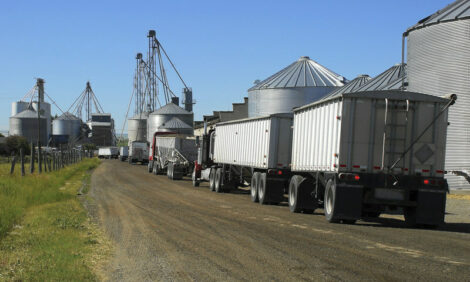



CME: Weak US $ Leads to Surge in Exports
US - CME's Daily Livestock Report for 4 January 2009.Staying with our recent demand theme — the University of
Missouri’s latest updates of its demand indexes showed a slight improvement
in December though year-to-date indexes remain well below
the level of 2007. Professor Glenn Grimes computes the numbers
monthly and has used estimates for December exports to arrive at these
figures. Actual export data for December will be released 11 February.
Prof. Grimes’ indexes estimate that the demands for
chicken, beef and pork all declined in 2008. Pork and broiler demand
were ahead of 2007’s level through April but weakened steadily through
November. Pork demand gained 0.1 per cent in December to close the year
4.1 per cent lower than in 2007. Broiler demand gained a full 1 per cent in December to
end the year 1 per cent lower than one year earlier.
Beef demand was below the level of 2007 in Grimes’ first estimate
in March. It, too, declined through November but gained 0.9 per cent in
December.
These calculations use an assumed elasticity of demand (these
use –0.75) and the actual percentage change in domestic per capita consumption
to compute an expected percentage price change. The actual
price change, based on USDA’s retail meat prices, is then compared to the
expected change and the difference is attributed to a change in demand —
ie. a move of the entire downward-sloping demand curve in the P-Q space
of a normal supply-demand diagram. The computation makes no inference
as to why the demand curve moved.
Pork and chicken exports in 2008 followed the same seasonal
pattern as was shows for beef yesterday — major surges in the summer
months before declining in the fall. Those export surges when the US
dollar was at its weakest may be having a disproportionate impact on
these domestic demand indexes. The reason is that higher exports manifest
themselves as lower computed domestic consumption since consumption
is, in fact, the residual of total supply (beginning inventory plus
imports plus production) over total MEASURED usage (exports and ending
inventory). Lower domestic consumption would mean lower domestic
per capita consumption, meaning that retail prices would have to rise —
perhaps sharply — for demand to be stable in these calculations.
Retail prices did not rise that quickly in 2008 but showed signs of
responding late in the year. Both beef and pork set records for retail price
in September with the all-beef price reaching $4.112/retail lb. and the pork
price reaching $3.026/retail pound. Chicken set a record for the composite
broiler price at $1.793/retail lb. in November. With the ongoing reductions
in all three sectors, these prices may well rise further — depending, of
course, on whether demand holds up in 2009.
Perhaps a more concerning aspect of the chart is the recent
downtrend for all three species. It has been all downhill since the Atkins
diet and 2008 just added another observation to the new trend(???).
Lower incomes will likely pressure the indexes again in 2009.









